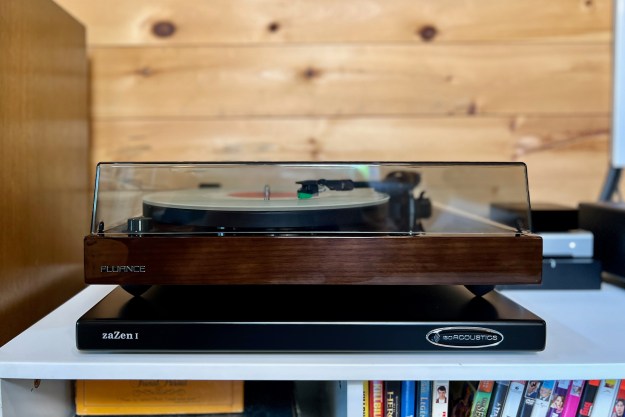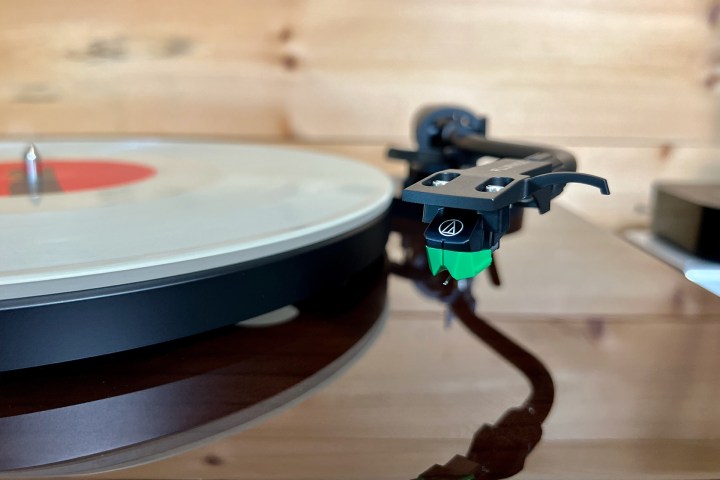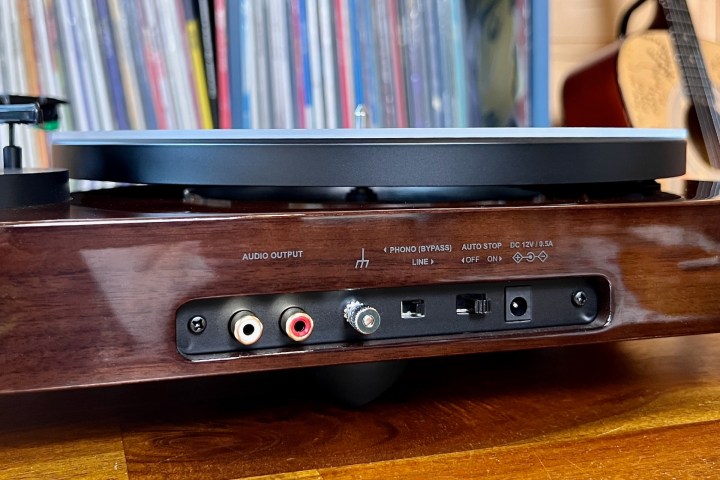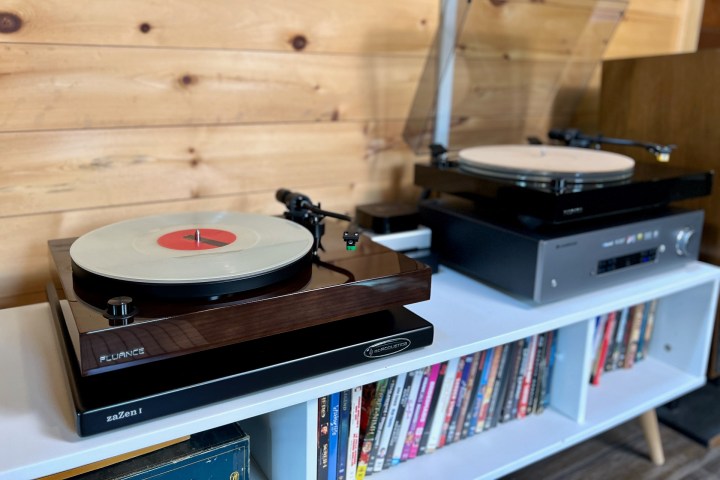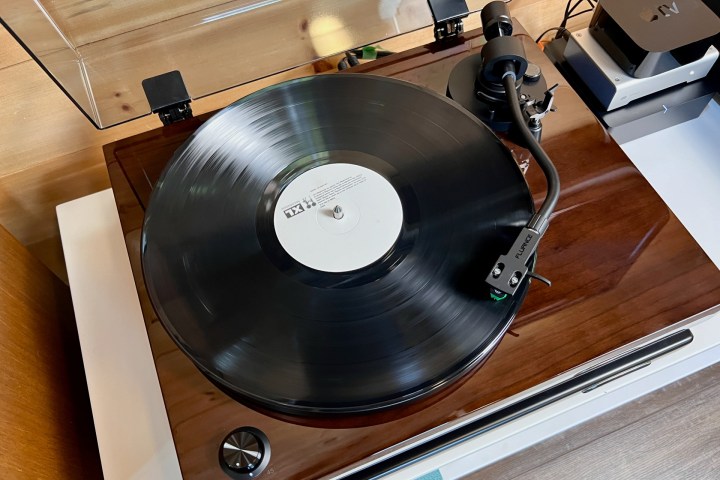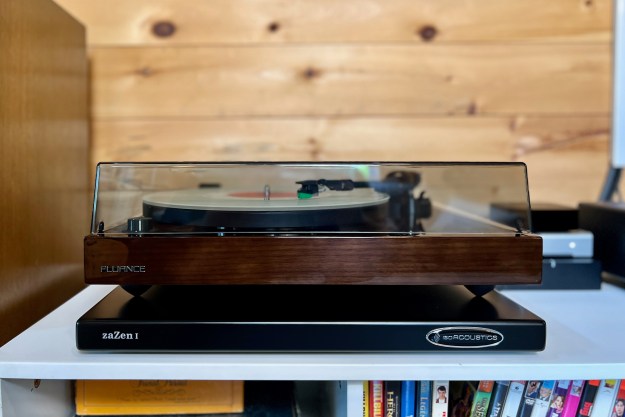
“Entry-level and beyond, the Fluance RT81+ Elite sounds great and is easy to use.”
- Hefty, sure-footed design
- Built-in phono preamp
- Upgradeable cartridge
- Speed control dial
- Auto-stop feature
- Acrylic mat adds nothing new
- Glossy finish attracts fingerprints
- No Bluetooth
One of my favorite turntables of the past year or so was the Fluance RT85N, a great-sounding $500 deck with a fantastic cartridge and well-made parts. It sits at the top of Fluance’s lineup of turntables that are known for their stability and sleek, glossy finishes, and it still gets a lot of play in my house. The Canadian audio maker continues to churn out some great stuff, with a particular penchant for hitting that trifecta of quality, affordability, and upgradeability, especially for that coveted entry-level market. This is where its latest turntable, the $300 Fluance RT81+ Elite, is sitting, quite literally, pretty.
The next generation of its popular RT81 Elite turntable, Fluance has given the RT81+ some key upgrades, including Audio-Technica’s latest VM95E moving magnet cartridge and a redesigned aluminum platter, as well as a little injection of DNA from the RT85N in the form of its conical isolation feet and a 3mm-thick acrylic mat that promises to further keep resonance at bay to coax the best sound possible out of the turntable.
After spending a few weeks with the Fluance RT81+ Elite I can say that beginners will be more than happy with its clean, full sound and ease of use, and even some intermediate-level, cost-conscious vinyl heads might be intrigued by the RT81+’s upgrade potential after just a few key tweaks. Let’s check it out.
Setup
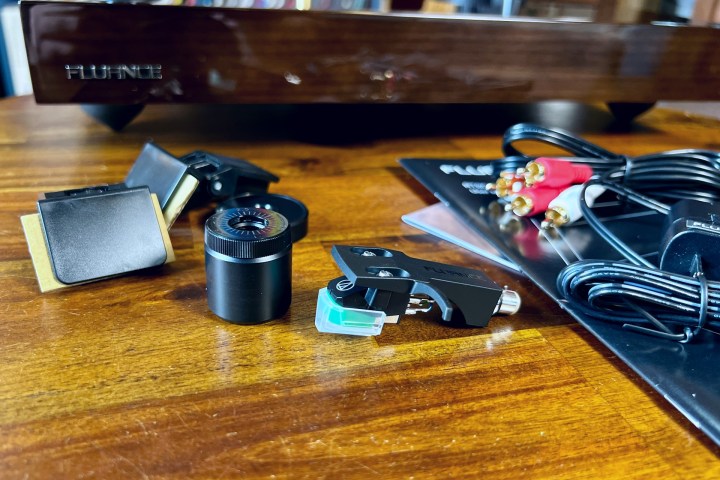
It’s nice to pull a turntable (or any gadget or piece of gear, for that matter) out of its box, plug it in, and go. But with turntables, I’ve found that most that boast plug-and-play readiness end up needing some kind of check or re-calibration of things like tracking force, anyway. For this reason, I actually prefer that there’s some assembly required with the RT81+ (or any turntable), and it’s easy enough that it shouldn’t scare anyone off. That said, the RT81+ does come almost assembled.
All that needs to be done is installing the platter and belt, screwing on the headshell with its pre-aligned cartridge to the tonearm, and sliding on the counterweight. Like all Fluance turntables, the included setup guide takes you through the rest of the process with easy-to-follow instructions on setting the tracking force and anti-skate to ensure that the stylus glides through your records’ grooves properly. Everything else needed is included – RCA cables, power adapter, and dust cover – and the whole setup and assembly process takes about 10 minutes (maybe a bit more if you’ve never done it before). Notably missing, though, was thoughtful pair of white gloves that came with the RT85N, but I suppose every bit counts when shaving $200 off the price.
Design and Build
The review unit that Fluance sent me is probably the finish I would have selected – a beautiful, dark walnut veneer with Fluance’s distinct high gloss that can be found on the piano black and piano white colors. The RT81+ is also available in matte black and white finishes, which might be better choices for those fussy about fingerprints because the walnut (and the piano black RT85N I have) do tend to pick them up more.
- 1. 3-mm acrylic anti-resonance mat
- 2. S-shaped tonearm
- 3. Rubber conical sound-isolation feet
- 4. 14-pound MDF wood plinth
Beneath those pretty finishes is Fluance’s “high-mass engineered” MDF (medium-density fiberboard) plinth that can be found on all of its turntables. The RT81+’s plinth weighs in at just over 14 pounds and sits atop three height-adjustable rubber feet that have been borrowed directly from turntables in Fluance’s higher-tier Reference lineup, which includes the RT85N. An upgrade from the RT81’s flat, puck-shaped feet, the new feet are cone-shaped for less surface contact and better sound isolation. Once placed down on my media unit, the turntable is stable and does not budge, which I prefer over lighter, waif-like decks that slide around when you lift the dust cover.
With anti-resonance top of mind for any turntable maker, Fluance has made some other changes with the RT81+. While aluminum platters can’t compete with the heavier solid acrylic or glass platters of more expensive turntables (like the RT85N’s), the RT81+’s new “dampened aluminum anti-resonant platter” is combined with a 3mm acrylic mat that is installed on top (replacing the usual rubber slip mat), “resulting in improved frequency response, enhanced imaging, and greater signal clarity,” Fluance says. What hasn’t changed is the tonearm, with Fluance opting to keep the same aluminum S-Type design of the RT81 (and other turntables in their lineup).
Features

The RT81+ is a belt-drive turntable, meaning that its DC motor is kept separate from the platter, connected only by a thin rubber belt to minimize any vibrations or motor noise. And while the RT81+ does get up to speed pretty quickly for a belt drive, DJs will probably want to look at torquier direct drive turntables, like the Audio-Technica LP120 series, with pitch shift and reverse features that the Fluance doesn’t have.
What the RT81+ does have, however, is a speed select dial for easy switching between 33⅓ or 45 RPM, a feature that many audiophile turntables don’t, and an auto-stop switch on the back that stops the platter spinning at the end of a record. It’s a little thing, but if you’re of the streaming generation and have never had to think about what happens after the music stops, without auto stop the record just keeps spinning, putting extra wear and tear on the stylus.
Looping back to what I said about plug-and-play, the RT81+ is like a lot of turntables hitting the market that appeal to those just getting started with vinyl, in that its connectivity is versatile out of the box. Its built-in preamp is switchable from phono to line-out, so it can be connected directly to powered speakers, amps, receivers, and other audio devices without the need (or extra expense) for an external phono pre. At this price range, the Texas Instruments preamp does its job, and I’ll get into how it sounds shortly, but as an advocate of turntables that give you upgrade options, the switchable preamp is a great starting point for most. It may be worth noting, however, that the RT81+ does not include Bluetooth connectivity, which may be a deal-breaker if your current setup consists of Bluetooth speakers.
- 1. The AT-VM95E cartridge
- 2. Built-in phono preamp
The last checkmark to get into is the upgrade Fluance has made to the RT81+’s cartridge. The Audio-Technica VM95E is the successor to its ubiquitous AT95E that can be found on all kinds of entry- and mid-range turntables, so it’s a no-brainer for Fluance to make this step up. The VM95E is a versatile cartridge that sounds great for most people and with most kinds of music. It has a bit more output than the AT95E and is fuller and more expressive. The stylus is easily replaced (for around $50) if it breaks or you just play the heck out of it, and should you want to swap out the cartridge altogether, the RT81+’s headshell will accommodate a range of higher-end carts, which is my favorite way to take a good turntable and make it great.
If, however, you already know you’re going to want a cartridge of a bit higher caliber, but you like the Fluance product range, you can always check out the RT82 Reference turntable for its Ortofon OM 10 for the same $300 price, or for $50 more the even better RT83 for its awesome Ortofon 2M Red. The only caveat with these choices, and all other Fluance Reference turntables, is that they do not include built-in preamps, which means you’ll need either a receiver with a phono input or an external phono pre.
Sound and performance

I tested out the Fluance RT81+ Elite (here’s a rundown of how we test turntables) through a few different sound setups, including a set of powered Edifier bookshelf speakers, but mainly through my Cambridge Audio CXA81 integrated amplifier (at around 35% volume) and a big pair of old ADS L520s that are big, bold, and a bit tempered in the highs, which turned out to be a good match with the shimmery VM95E. I switched back and forth between the RT81+’s built-in Texas Instruments preamp and my $150 Schiit Mani external phono preamp.
For the low-end gauntlet, I pushed my go-to Billie Eilish tracks xanny and Bad Guy through, as well as some Radiohead, and Massive Attack’s Angel from Mezzanine for good measure. For a $70 cartridge on a $300 turntable, this thing can fill a room. The bass is smooth, full, not boomy (even with Billie), and well-controlled. The bassline on Radiohead’s Airbag sounds great, and punchy as it should when veering into the mid frequencies, which also sound as good as they should. Kick drums are suitably punchy and tight, and Queens of the Stone Age’s latest record, In Times New Roman, showed off its crunchy lead guitars. Even Miles Davis’ trumpet, and even the chirpier, spacey parts of Subterranean Homesick Alien are on par. As expected, though, switching to my Schiit Mani external preamp gives everything a bit of a volume bump and smooths the sound more for better control. Necessary? No. Worth the extra money? Always, especially when getting into the high frequencies and trebles.
Speaking of, cymbals, hi-hats, and tambourines, they sound crisp and clean on the RT81+, and while vocal “esses” started out a little sibilant, things improved after the VM95E’s stylus was broken in (it takes about 20 hours of playback for this). To test out the RT81+’s new 3mm acrylic mat, I compared it to a rubber slip mat, a cork slip mat, and even different combinations of the three, but I could find little or no difference.
- 1. Fluance RT81+ next to the Fluance RT85N.
- 2. RT81+ spinning OK Computer.
Oh, and because I had a Fluance RT85N nearby, out of curiosity I swapped out the VM95E for the 85N’s higher-end Nagaoka MP-110 cartridge to check the difference. The headshells are exactly the same, so it only took a few minutes to recalibrate the tracking force. It’s no surprise that the Nagaoka performed better, eliminating any sibilance, delivering better soundstage and detail, and providing a little more volume output. But, that’s not to say that the Audio-Technica cartridge doesn’t hold its own. It’s a solid out-of-the-box cartridge that’s great to get started with and that will last for years. But if and when you’re ready, it goes to show what a $135 cartridge upgrade can do, which is a big part of the appeal of the RT81+ Elite.
Overall, I found the sound from the RT81+ to be dynamic, with a wide and relatively high soundstage, and good instrument separation across everything from jazz and orchestral movie scores to metal, rock, and hip-hop. And while the smaller powered Edifier speakers didn’t pack quite the bass punch, they still matched well with the turntable, easily filling my smaller living room, proving to me that the RT81+ can play well with a range of different speakers and setups.
The bottom line
The Fluance RT81+ Elite is a great-sounding entry-level turntable, for a reasonable $300, that builds on Fluance’s reputation for tank-solid, sleek-looking products made from quality parts. It’s easy to assemble and operate, and its built-in, switchable phono preamp not only negates the need for purchasing any other components to get spinning, but it also gives you the flexibility to connect to a wide variety of audio systems and/or upgrade it for improved performance, should you want. The same can be said of the RT81+’s new Audio-Technica cartridge. The VM95E is a workhorse that sounds good with many types of music and is more than capable in the grooves for years. It’s not for audiophiles, though, and that’s fine, but should you want to upgrade or try something new, you can without having to start from scratch.
As mentioned above, there are other options in the Fluance lineup that offer better cartridge options that are around the same price range, but without the built-in preamp. Casual listeners and beginners will be totally satisfied with the RT81+’s preamp, but adding an external preamp almost always improves sound quality, so if you think you might head down the road to audiophilia, keep that in mind.
Competition-wise, other established brands such as Pro-Ject and Audio-Technica offer options that look great and have comparable components like A-T and Ortofon cartridges, belt drives, and built-in preamps at around the same price point. Audio-Technica’s AT-LP60BT, for example, is $300 and offers Bluetooth connectivity, too, while the Pro-Ject E1 bares the Pro-Ject name (which accounts for some of its $100 premium over the RT81+) and its sophisticated design aesthetic. Where Fluance has them beat, though, is in their sure-footed, weighty plinth style and design that just screams longevity, whether you leave it as it is or soup it up.
Editors’ Recommendations
Services Marketplace – Listings, Bookings & Reviews
